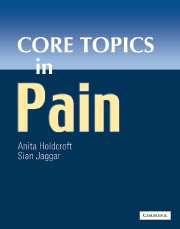Book contents
- Frontmatter
- Contents
- Contributors
- Preface
- Acknowledgements
- Foreword
- General abbreviations
- Basic science abbreviations
- PART 1 BASIC SCIENCE
- PART 2 PAIN ASSESSMENT
- Section 2a Pain measurement
- Section 2b Diagnostic strategies
- PART 3 PAIN IN THE CLINICAL SETTING
- Section 3a Clinical presentations
- Section 3b Pain syndromes
- PART 4 THE ROLE OF EVIDENCE IN PAIN MANAGEMENT
- PART 5 TREATMENT OF PAIN
- Section 5a General Principles
- Section 5b Physical treatments
- 34 Physiotherapy management of pain
- 35 Regional nerve blocks
- 36 Principles of transcutaneous electrical nerve stimulation
- 37 Acupuncture
- 38 Neurosurgery for the relief of chronic pain
- Section 5c Pharmacology
- Section 5d Psychosocial
- PART 6 SUMMARIES
- Glossary
- Index
35 - Regional nerve blocks
from Section 5b - Physical treatments
Published online by Cambridge University Press: 10 December 2009
- Frontmatter
- Contents
- Contributors
- Preface
- Acknowledgements
- Foreword
- General abbreviations
- Basic science abbreviations
- PART 1 BASIC SCIENCE
- PART 2 PAIN ASSESSMENT
- Section 2a Pain measurement
- Section 2b Diagnostic strategies
- PART 3 PAIN IN THE CLINICAL SETTING
- Section 3a Clinical presentations
- Section 3b Pain syndromes
- PART 4 THE ROLE OF EVIDENCE IN PAIN MANAGEMENT
- PART 5 TREATMENT OF PAIN
- Section 5a General Principles
- Section 5b Physical treatments
- 34 Physiotherapy management of pain
- 35 Regional nerve blocks
- 36 Principles of transcutaneous electrical nerve stimulation
- 37 Acupuncture
- 38 Neurosurgery for the relief of chronic pain
- Section 5c Pharmacology
- Section 5d Psychosocial
- PART 6 SUMMARIES
- Glossary
- Index
Summary
The conduction of action potentials along nerve fibres may be blocked by physical and pharmacological methods. The susceptibility of nerve fibres to such block is affected by their state of firing, their size and whether myelinated or not (e.g. Aδ fibres are myelinated and C-fibres are not). Nerve conduction may be blocked anywhere along the pain pathways, from nerve ending to the central nervous system.
Physical means of neural blockade include:
Cold.
Heat.
Pressure.
Larrey described refrigeration anaesthesia during the French retreat from Moscow (1812), but in modern anaesthetic practice, the use of cold to achieve conduction block is largely limited to transient, topical anaesthesia (e.g. ethyl chloride spray). The application of heat may be used to produce permanent nerve block (e.g. radio-frequency lesions of the trigeminal ganglion in the treatment of trigeminal neuralgia). Pressure neural blockade is usually inadvertent (poor positioning on the operating table), but remarkably effective. It provides a portion of the analgesia observed with the use of intravenous regional anaesthesia (Bier's block).
Pharmacologic nerve block may be temporary (using local anaesthetics or other agents, e.g. pethidine) or permanent (using neurolytic chemicals).
Temporary/reversible pharmacological nerve blockade in the acute setting (e.g. surgery)
History of local anaesthetics
The introduction of cocaine (a naturally occurring alkaloid ester) by Koller and Freud for topical eye anaesthesia (1884), led to enthusiastic experimentation with the agent.
- Type
- Chapter
- Information
- Core Topics in Pain , pp. 235 - 240Publisher: Cambridge University PressPrint publication year: 2005

